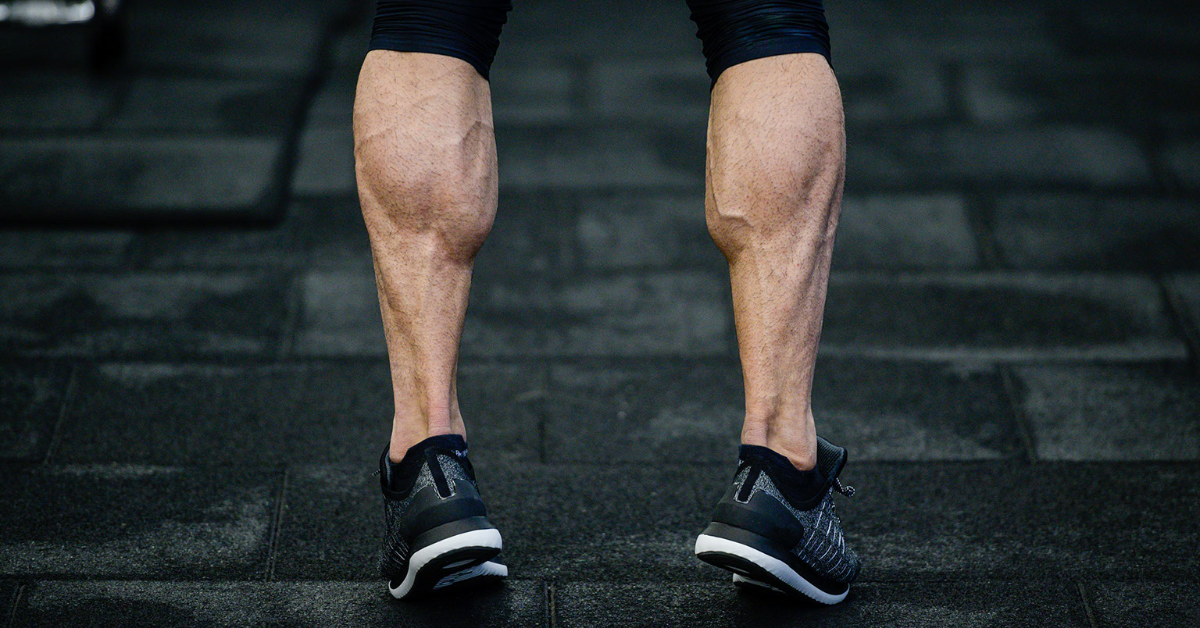While resistance training for the calf muscles is typically the butt of jokes in bodybuilding gym culture, there are some legitimate benefits to increasing the strength of your calf muscles that the bodybuilders may have inadvertently been correct about. The calf contains two main muscles that serve to flex the ankle downwards, an action known as plantarflexion. These muscles include the superficial gastrocnemius, which consists of two muscle heads and crosses both the knee and ankle joint, and the deeper soleus, which only crosses the ankle. Both of these muscles attach to the Achilles tendon, which acts as the main propulsion system for the foot and ankle complex during walking and running. Together, these muscles provide higher ground reaction forces than the quadriceps during various running speeds, which suggests that running is predominantly an ankle activity in terms of muscle forces (Schache 2014).
The soleus has a larger cross-sectional area, an ability to produce higher forces, and an ability to maintain force production with the knee flexed. These characteristics give the soleus particular significance during walking and running (Dorn 2012). When analyzed at speeds ranging from walking at 1.5 mph to running at 11.0 mph, peak ankle power increases by 23-fold while peak soleus activity increases by 3.5-fold. This reflects a shift in the soleus’ role to a predominantly isometric force generator that transfers power to the Achilles tendon (Lai 2015). Therefore, the soleus becomes integral in allowing us to “bounce” while we run, making us more efficient in this activity.
Force production by the calf muscles is clearly important for running performance, but is also protective against Achilles tendinopathy in runners. In a 2019 study by O’Neill, healthy runners demonstrated the ability to produce 200% bodyweight plantarflexor torque during dynamometer testing, while runners with unilateral Achilles tendinopathy demonstrated deficits on both sides, producing only up to 130% bodyweight force. In this same study, runners with Achilles tendinopathy also demonstrated significant differences in plantarflexor endurance compared to healthy runners. With similar findings found at both knee extended and flexed positions in this study, it can be hypothesized that the soleus remains the primary force generator, with its twice-bodyweight force output equating to an intramuscular force of six to eight times bodyweight.
While you may not participate in running, there’s still reason to pay attention to calf muscle performance, as there is evidence supporting plantarflexor strength as a protector of walking function as we age. In a study by Stenroth et al (2015), plantarflexor strength played a more significant role in walking capacity and speed in healthy older adults when compared to lower extremity lean mass or leg extension strength or power (although leg extension power was a close second, so keep squatting). These findings are important since tests of walking capacity and speed are often used in physical rehabilitation to assess deficits in physical function.
So where do we start if one wants to participate in calf resistance training? Adding some simple calf exercises 1-2 times per week is an easy place to begin, and if you’re familiar with our templates, this can be a great addition to your GPP day(s). Ideally we’d train two movements, one with the knee extended and the other with the knee flexed to target the soleus on the latter. Below is a sample programming approach:
- Day 1) Seated Barbell Calf Raise: 8 reps @ RPE 7-8 x 2-3 sets
- Day 2) Single Leg Deficit Calf Raise: 8 reps /side @ RPE 7-8 x 2-3 sets
Caveat: If you’re already dealing with Achilles tendinopathy, programming and advice may differ. Please feel free to reach out to our Pain & Rehab division for more information.
References:
Dorn TW, Schache AG, Pandy MG. Muscular strategy shift in human running: dependence of running speed on hip and ankle muscle performance. J Exp Biol. 2012 Jun 1;215(Pt 11):1944-56
Lai A, Lichtwark GA, Schache AG, Lin YC, Brown NA, Pandy MG. In vivo behavior of the human soleus muscle with increasing walking and running speeds. J Appl Physiol (1985). 2015 May 15;118(10):1266-75
O’Neill S, Barry S, Watson P. Plantarflexor strength and endurance deficits associated with mid-portion Achilles tendinopathy: The role of soleus. Phys Ther Sport. 2019 May;37:69-76
Schache AG, Dorn TW, Williams GP, Brown NA, Pandy MG. Lower-limb muscular strategies for increasing running speed. J Orthop Sports Phys Ther. 2014 Oct;44(10):813-24.
Stenroth L, Sillanpää E, McPhee JS, Narici MV, Gapeyeva H, Pääsuke M, Barnouin Y, Hogrel JY, Butler-Browne G, Bijlsma A, Meskers CG, Maier AB, Finni T, Sipilä S. Plantarflexor Muscle-Tendon Properties are Associated With Mobility in Healthy Older Adults. J Gerontol A Biol Sci Med Sci. 2015 Aug;70(8):996-1002.
